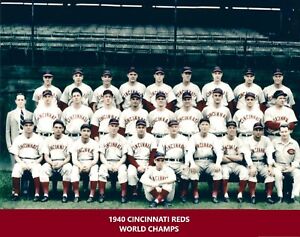After floundering on the field through the late 1920s, the Reds fell into bankruptcy in 1931 before being bought by Powel Crosley, owner of a powerful radio station as well as a manufacturer of radios, appliances, other household items, and later cars. His first move was to hire Larry MacPhail as general manager.
New owner brings changes
Crosley had made his fortune manufacturing refrigerators and radios. He was also a pioneer in radio and owned the largest station in town, and one of the biggest in the nation, WLW. Redland field became Crosley Field in 1934, and the Reds embarked on a new era.
Redland field became Crosley Field, and MacPhail immediately began building the Reds farm system. He also introduced several firsts to Major League Baseball, including the introduction of regularly scheduled night games, beginning in 1935, and fireworks following some contests.
Winning ways return
The Reds gradually improved capturing the National League pennant in 1939, before losing to the New York Yankees in the World Series. In 1940, the Reds made it over the hump for the first time since the controversial 1919 World Series, downing the Detroit Tigers four games to three.
The team’s fortunes gradually declined after that, largely due to an aging roster and the onset of World War II. There were a few highlights here and there, though. For example, in 1944, a 15-year old from Hamilton, Ohio, named Joe Nuxhall, made his debut for the Reds, the youngest person ever to play in the Major Leagues. That record still stands. In 1954, Ted Kluszewski led the NL in home runs with 49.
A new nickname
A year earlier, GM Gabe Paul announced that the team would prefer to be called “Redlegs” as opposed to just Reds. According to newspapers reports, “no reason has been given for the change, and it has not been accepted generally by writers and fans, who hold to the habit of calling them The Reds.” The name was used until the end of the 1958 season when it officially went back to Reds. Many speculated that the nickname was changed from Reds due to the so-called Red Scare of the era, in which several government leaders tried to expose a communist threat to the United States.
Back on the field, the Reds dwelled in the middle of the NL standings before bouncing back and finishing third in 1956. They also had a corresponding uptick in attendance. The following year, though, rumors began to swirl that the team was going to move to New York City.
A new city?
The Brooklyn Dodgers and New York Giants had relocated to Los Angeles and San Francisco, respectively, for the 1957 season. New York immediately began looking for a team to replace the departed clubs and keep the city in the National League. At around this time, Powel Crosley was growing increasingly agitated with the sparse parking conditions at Crosley Field. He had no intention of moving the club but was able to use the notion as leverage to get some of the improvements he sought.
In 1961, the Reds made it back to the World Series, where they fell to the New York Yankees in five games. Sadly, Powell Crosley passed away in the spring of that year and didn’t see the team’s pennant-winning run. On March 27, 1962, a day before the first anniversary of Crosley’s death, Bill DeWitt bought Reds for a down payment of $1,250,000, on a sale price of $3,500,000.
A year later, DeWitt, disappointed with the team’s anemic attendance and aging ballpark, started entertaining offers from out-of-town interests to purchase the club and likely move it. The three leading candidates were Atlanta, Dallas, and San Diego, the latter the home of the Reds AAA farm team at the time.
However, the announcement of a new stadium to be located on the river compelled DeWitt to hang on to the team and keep them in Cincinnati, where they began building what would become, arguably, the best team in baseball history a decade later.



68 comments
Thomas Gibson
I want to use this opportunity to tell the whole world on how I become rich and famous. I’m 93 years old. I was passing through difficulty in business and there was no hope of me coming out of my debt. I borrow money in my bank to do my business and I run at lost on the business I got frustrated and decided to be playing lottery to see if I can win and make my business grow and I have played for years now nothing good is coming my way on till I meet someone online talking about Dr Ayoola on the internet. He was taking about how this Dr Ayoola help him to win mega million lottery game. I said to myself if this is true and decide to contact him and told him to help me as well I later read more about this man and see how he has been helping people all over the world. I have faith in him and choose to work with him. After working with him he told me what I need to do for the number to be given to me which I did after he finish working he said I will have a dream and the number will be review to me in the dream. That night has I was sleeping I dream a number immediately he call me and gave me the same number I dream of and ask me to go and play the number. Today I’m here testifying of the good work he did for me I played the number and I won the sum of 1, 000,000 million dollars in a lotto max. You can contact Dr Ayoola for help if you want to win big in lottery game he has the gift of giving right number contact him today and thank me email him today Via email: drayoolasolutionhome@gmail. com or https://www.facebook.com/Dr-Ayoola-105640401516053/ text or call +14809032128
Jason Bennett
Omg I Finally Got Helped !! I’m so excited right now, I just have to share my testimony on this Forum.. The feeling of being loved takes away so much burden from our shoulders. I had all this but I made a big mistake when I cheated on my wife with another woman and my wife left me for over 4 months after she found out.. I was lonely, sad and devastated. Luckily I was directed to a very powerful spell caster Dr Emu who helped me cast a spell of reconciliation on our Relationship and he brought back my wife and now she loves me far more than ever.. I’m so happy with life now. Thank you so much Dr Emu, kindly Contact Dr Emu Today and get any kind of help you want.. Via Email emutemple@gmail.com or Call/WhatsApp cell number +2347012841542
Https://web.facebook.com/Emu-Temple-104891335203341
kbvsMlFxfuGJ
tkwcdDBMgRX
rkElohNdWQqnpiDt
kpsEfFhjxeg
ZePKyrdOUIlnFp
lTUGhowLAOX
Leave a comment
This site is protected by hCaptcha and the hCaptcha Privacy Policy and Terms of Service apply.